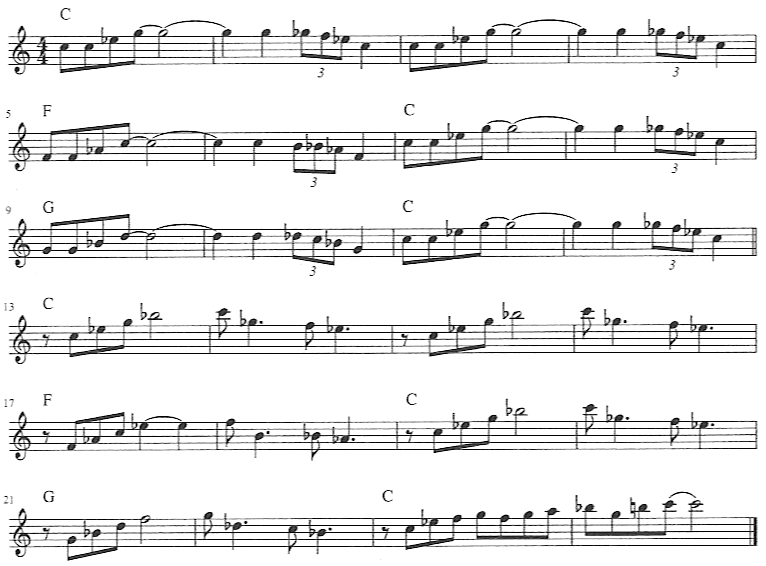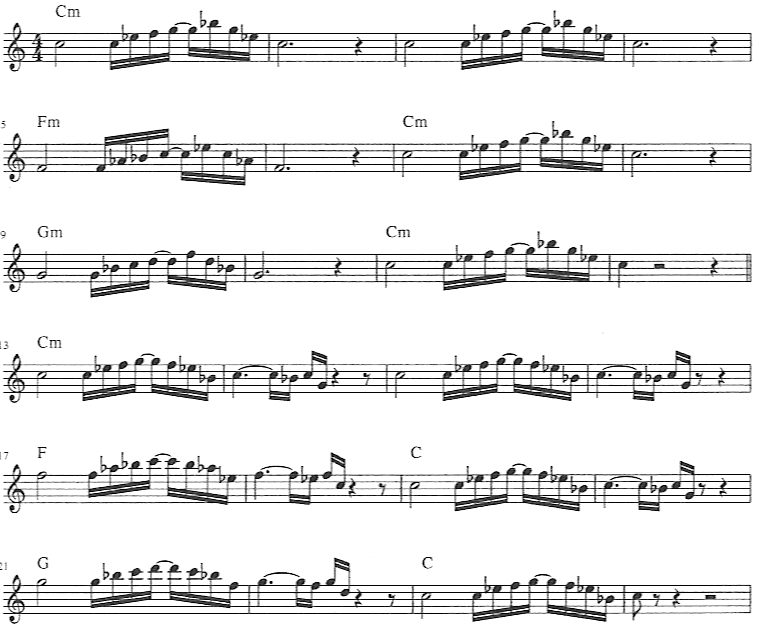Introduction
These 3 video lessons will demonstrate the proper use for each of the scales discussed (basic blues, pentatonic major and pentatonic minor). The point is to learn and memorize the exercises because they contain all the notes of the respective scales.
Then take advantage of the backing tracks to work out these scales at first, then the written exercises and finally work on your own variations. You can also use the licks from the “7 Licks” section to use as a starting point for your solos over the backing tracks. (The backing tracks on this page are shorter in length than the versions on the Backing Tracks Section).
1. Basic Blues Scale

Our first playing lesson consists of two exercises played back-to-back over a 24 bar medium shuffle straight-ahead blues track. The first exercise establishes the first five notes of the blues scale, the second brings in the flat 7th and 8th (octave). Notice how the flat 5 is emphasized and not just used as a passing note of the scale. Give a listen and then go for it!
Play Sax Audio:
Play Backing Tracks:
2. Pentatonic Major Scale
Play Sax Audio:
Play Backing Tracks:
*New Adding notes to the pentatonic major scale – tenor
You’re not restricted to only playing these notes during a solo. Scales are good guidelines and help us to learn what will work within a certain set of rules but these rules can be stretched and even broken.
In the following audio example I start the solo by playing the notes of the pentatonic major scale. I go up the scale once to establish the key and scale and then expand upon it immediately. Adding a minor 3rd and flat 7 are usually a great idea. These are two of the notes that all blues-based music loves! Listen to the audio and follow along with the music then learn it and add it to the basic scale while practicing with the backing tracks.
Remember, the pentatonic major scale is 1 2 3 5 6. In C, as is below for tenors these numbers equate to C D E G A. If you follow along you can see where I deviated from this scale and played the flat 3 and 7. Not only does it work, it sets up the upcoming 4 chord really well with that flat 7 leading into it.
Listen to audio example
There is much value in learning, and finally memorizing a 12 bar solo like this. You can use it over so many situations when playing with a band, a jam session etc. Once you have learned it and commit it to memory start learning it in the next key one tone higher, one tone lower and so on. This is why we use numbers sometimes instead of notes – if you know that 1 2 3 5 6 are the notes of the pentatonic major scale, you should be able to start on any scale and play it, assuming you know all the major scales of course.
3. Pentatonic Minor Scale

This one has more of a bluesy sound because of the flat 3rd and flat 7th. The first exercise simply goes up and back down the scale, and the second time around goes as far up as the 5th and back down to play the flat 7 and 5th below the tonic not so we hit them from a different angle.
Played on tenor
Play Sax Audio:
Play Backing Tracks:
*Note – you’ll notice that all exercises are in the key of Bb (concert). This is for good reason; tenor and soprano saxes will be in their key of C, alto and baritone saxes will be in their key of G. These are two of the most popular and fortunately the easiest to play so are an excellent choice to learn these lessons on. You will also get proficient on the 4 and 5 chords of these keys because you are also playing the exercises through the entire 12 bar blues progression.
How Do You Know Which Scale To Use When Playing Songs?
Generally speaking, when a song is in a minor key you will use the minor scale, when in a major key you have more than one option. Of the three examples above, two are major and one is minor but I used a minor scale in the first example even though the tune is in a major key.
If you examine these two scales; the basic blues and the major pentatonic, you’ll see on paper they are quite different – one has a minor 3rd, a 4th and no 6th while the other has a major 3rd, no 4th and has a 6th yet both these scales are interchangeable when playing in a major key.
Still, we need to learn them individually and practice them separately. When they are a natural part of your musical vocabulary and you start playing different songs you’ll know almost immediately which of these scales will sound right in the music you’re playing.






